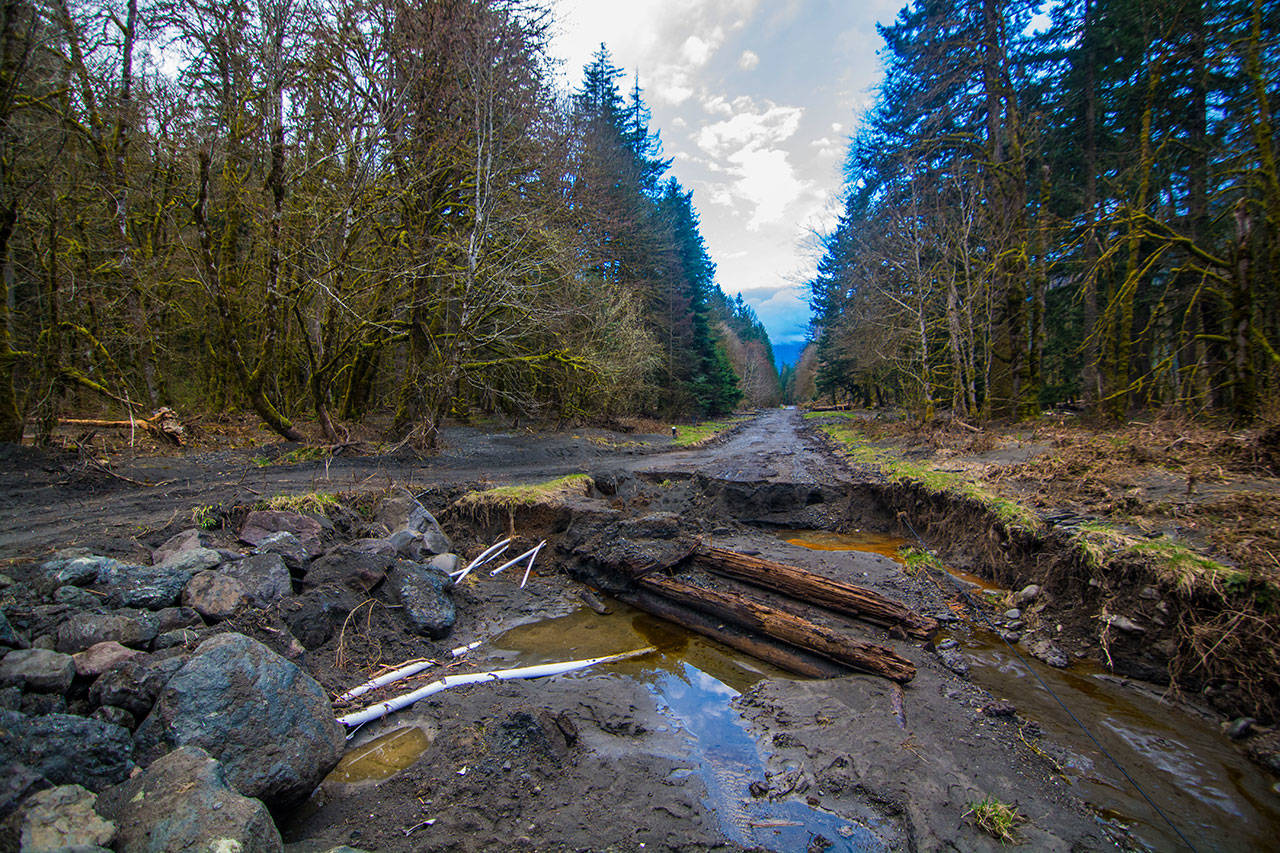OLYMPIC NATIONAL PARK — Olympic National Park might not restore vehicle access to the Elwha River Valley until a long-term solution is in place, and the park is now asking for public input as it looks at relocating Olympic Hot Springs Road to a higher elevation, officials said Monday.
The park is preparing an Environmental Assessment on a proposed geotechnical investigation, which would help park officials find a new location for a stretch of the road that has been damaged by the river.
Comments on the study will be accepted until April 1. Park officials hope to begin the potentially year-long study this summer or fall.
“We’re doing this to examine the feasibility of moving the road,” said Penny Wagner, spokesperson for the park. “We need to find that out before we can move forward.”
The study would include 28 borings along existing roadway and off-road along a one-mile stretch of the slope east of Olympic Hot Springs Road to investigate the stability of the slope, Wagner said.
The off-road testing would require constructing an access path up to 10 feet wide and about 4,800 feet long. It would start about 1,000 feet north of the Elwha Ranger Station and end about 800 feet north of Sanders Creek temporary bridge.
Once the study is finished, the park would continue preparing another environmental assessment that would address relocating the road, modifying the road on the current alignment or doing nothing.
The Elwha River has repeatedly destroyed the road since removal of the Elwha and Glines Canyon dams was finished in 2014, an issue identified in the 2005 Final Supplemental Environmental Impact Statement.
That SEIS said the park could mitigate for flooding in that area by raising about one mile of the road by 1 foot and adding riprap to select sections of the road.
But with the river now flowing through Olympic Hot Springs Road for the second time since 2015, officials said they are going to concentrate their efforts on a long-term solution.
“It doesn’t appear vehicle access will be an option for this summer,” said Wagner. “It’s just going to depend on what the river does. It could have to wait until implementation.”
If the process goes smoothly, vehicle access could be restored in 2020 or 2021, Wagner said, adding that officials will continue to monitor conditions to see if it makes sense to restore temporary access earlier.
Frequent flooding
Christina Miller, planning program manager for the park, said Olympic National Park has been working on that solution for the past few years, but each time the river has destroyed the road, the park’s resources have been redirected to restoring temporary vehicle access.
A flood destroyed a section of the road near the former Elwha Campground in December, forcing park officials to close the gate on Olympic Hot Springs Road near the Madison Falls trailhead.
Storms in November 2015 washed out a nearby section of road, but crews installed a temporary bridge to carry traffic over the reactivated channel of the river.
The road reopened in January 2017, but closed again three weeks later after heavy rain and snow melt caused the swollen river to flow through the former Elwha Campground.
“We were getting ready to do scoping on the long-term [solution], but we kept having storm damage and the river totally shifted,” Miller said. “It’s all the same people working on everything. We don’t have a vast and wide staff to address several different plans.”
Work on the Environmental Assessment for relocating the road was put on hold when planners realized they would need the geotechnical investigation to determine the feasibility of moving the road.
Though officials are working to maintain visitor access for the long term, the process can be lengthy and “in the federal government, things don’t happen overnight,” Miller said. “I hope people understand we are very much trying to find a way to provide access.
“We have this amazing lookout at Glines Canyon and we want people to get there.”
In all, the park has spent $450,000 on its temporary efforts to maintain visitor access in Elwha River Valley.
Wagner said when the park invests the public’s money into a project, it wants to be responsible and be sure the improvements will last.
“We don’t want to continue putting money into something where the river is just going to leave us with no access,” she said. “We understand how important it is to get up there. It’s an important area for the park and … we want to maintain that access for folks.”
________
Reporter Jesse Major can be reached at 360-452-2345, ext. 56250, or at jmajor@peninsuladailynews.com.

